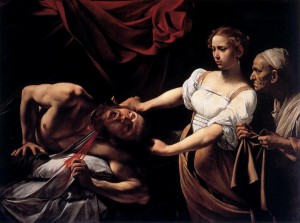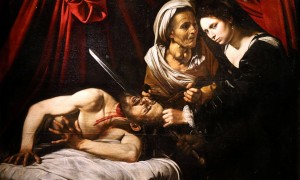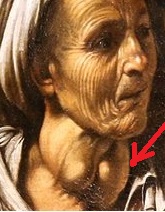Friday, April 15th, 2016...12:21 am
A Caravaggio in the Attic
Finding a long lost treasure is headline material. Should the trove be a multi-million dollar painting by a master, it generates additional press coverage and ratings. A version of Judith Beheading Holofernes discovered in a Toulouse attic is being attributed to Caravaggio.
il mistero del Caravaggio ritrovato in soffitta (La Repubblica) click
Caravaggio Masterpice (ArtInfo) click
“Lost Caravaggio Causes a Rift” (The Guardian) click
Let’s compare the Toulouse candidate to the Galleria Nazionale d’arte antica, Palazzo Barberini Judith Beheading and notice some interesting details. The Roman piece was a product of Caravaggio’s stay at the Palazzo Madama working for Cardinal Francesco Maria del Monte.

Judith Beheading Holofernes, c. 1598-1599, Galleria Nazionale d’arte antica. Painted for Cardinale del Monte.
Let us now look at the Toulouse candidate:
Let us compare the Holofernes on the Toulouse candidate and the Barberini Judith Beheading.

Comparison of Holofernes. The Toulouse candidate is on the left, the Barberini Judith Beheading is on the right.
Are we in the presence of the same painter? Would this be Caravaggio?
Catherine Puglisi in her 1998 Caravaggio monograph (Phaidon) states “choosing a distinct moment in the narrative, Caravaggio boldly represented Judith slicing Holofernes’s neck with his sword. This choice of the climax must have challenged him to consider the question of exactly how a woman decapitated a strong man and to reconstruct the physical as well as the emotional experience (page 69).” In the Barberini piece, Puglisi notices “Caravaggio’s skillful command of expression… Judith’s face presents the most impressive study in expression. A few lines disturb her smooth brow, dark shadows partially obscure her eyes fixed on Holofernes, and her lips are slightly parted. That she is deeply troubled and even repelled by this act is heightened by the arc traced by her body, curving back from her victim at the shoulders at the legs where her skirt is swept up. (page 70). ” How dramatically consistent would it be for Judith, in the Toulouse candidate, to be slaying a strong man who fights for his life while she looks away, at the spectator? The force used to grab the Assyrian general’s hair is totally absent from the French candidate.
Caravaggio’s peripatetic lifestyle during this period (Naples, Valletta, Syracuse, Messina, Palermo, Naples) makes an identification of the models difficult, not the case with the Barberini Judith Beheading. Of the period of the Toulouse candidate, a simple look at the London’s National Gallery Salome with the Head of Saint John the Baptist and the Borghese’s David with the Head of Goliath make the French Judith Beheading more problematic. The provenance research presented just points to the existence of a second version of the Judith painted at Del Monte’s Palazzo Madama.
Moving beyond from experts’ opinions, the public has not been presented with real evidence: X-rays, brushstroke pattern, chemical analysis of the pigments (comparison is possible to paintings of the period), infrared imaging spectroscopy, reflectography, Luminescence Imaging Spectroscopy, pentimenti to aid in the attribution process. It is often the case that iconography and poor research justify the existence of a masterpiece where there is none. Opinion often bypasses the role of serious scientific study. Art historians and the French people are owed the results of thorough scientific inquiry and the new algorithms in place to avoid speculation based on inflated scholarly egos.






Comments are closed.